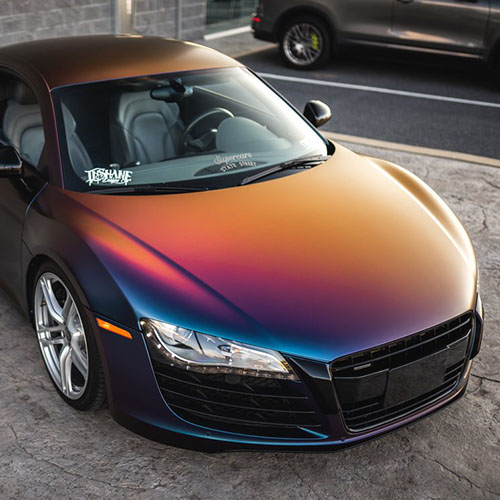
Color Change Vinyl Wrap
Color change vinyl wrap is by far the best way to change your car’s entire body color. It costs a fraction of what a paint job would, it only takes 2-3 days to complete and it ‘s removable. Instead of degrading your vehicle’s resale value, it actually preserves it thanks to the fact that vinyl protects the original paint of your automobile and doesn’t damage it when it’s time to take it off.
Rodz Tint Touch’s team of vinyl wrap experts will install the material with minimal seams, no bubbles, no tears and absolutely no wrinkles. You can also expect proper tucking over corners, making it appear like the material came with the car by default.
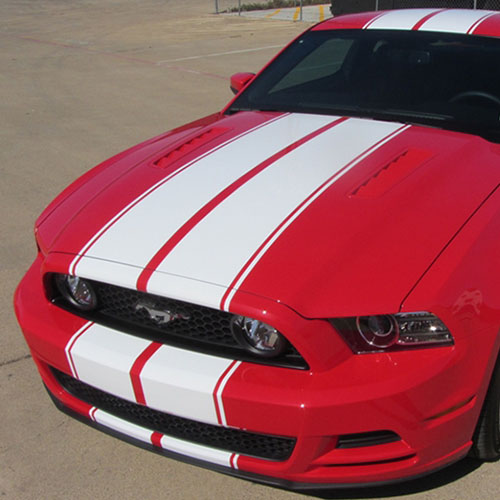
Vinyl Racing Stripes
Looking to give your car a more aggressive look? Vinyl racing stripes are the best way to do it. These aesthetic additions instantly produce a sportier appeal on your vehicle, making it a head-turner without breaking the bank. Rodz Tint Touch has a variety of vinyl wrap colors in stock, so you’ll be able to add the perfect accent to your paint job.
Unlike color change vinyl wraps that cover the entirety of your vehicle’s body, racing stripes only need to be installed over small sections of it. This means that the vinyl has to be installed with the utmost care and precision. Fortunately, our team of vinyl wrap experts have the tools, skills, and experience to do just that. When you get your racing stripes from Rodz Tint Touch, you can be sure they’re exactly on the right spots and at the right sizes.
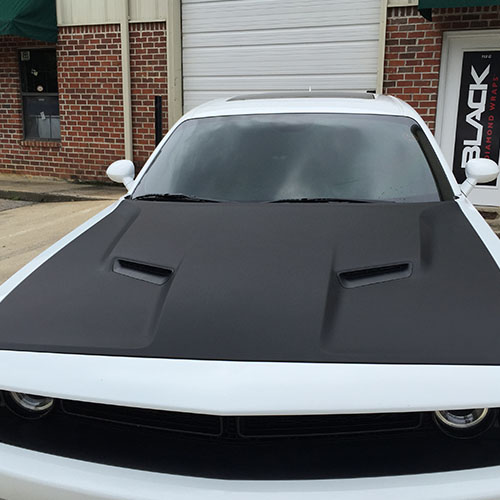
Vinyl Hood Wrap
Want to give your vehicle a slight color accent and not a full color change? A vinyl hood wrap job might just be what you’re looking for. As the name of the service suggests, this is a wrap that covers only your hood, giving it a sportier two-tone look without overhauling the entire aesthetic. If your hood has some damage or scratches, this is also an excellent way to cover them up and restore your car’s appearance.
Our team of professional vinyl wrap installers can cover your hood and make it look like it’s been repainted as opposed to just covered. With years of experience, we’ve perfected the art of laying vinyl over car bodies without bubbles, wrinkles and tears. After polishing, the vinyl will gain a metallic sheen that will have most people assuming that you had your hood repainted.
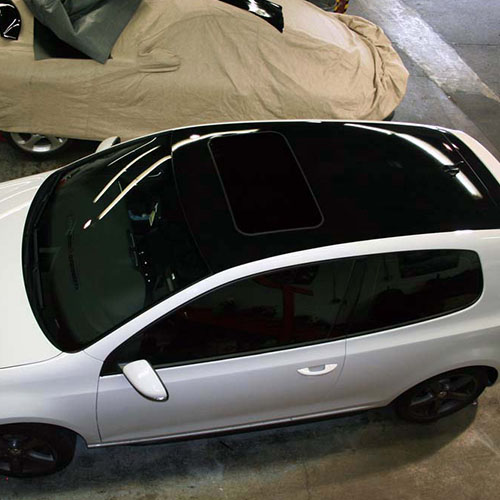
Vinyl Roof Wrap
Car roofs are often the most damaged areas due to their direct exposure to the sun and the accumulation of water beads. The marks that nature will leave behind can be pretty ugly and can adversely affect your vehicle’s resale value. Fortunately, vinyl wraps can provide an affordable and effective solution to this problem. This layer of physical protection also gives your car a two-tone look, making it look sportier and more exciting.
From an installation perspective, vinyl roof wraps are probably the hardest to apply on a vehicle. The elevation, the protrusion of the antenna and the ridges on the roofs of some vehicle models can make the process pretty complicated. Fortunately, Rodz Tint Touch has a team of experts who’ve accumulated years of experience on this vinyl application. When you entrust your vinyl roof wrap job to us, you can be sure that the vinyl comes out evenly placed, precisely cut and free of wrinkles and bubbles.
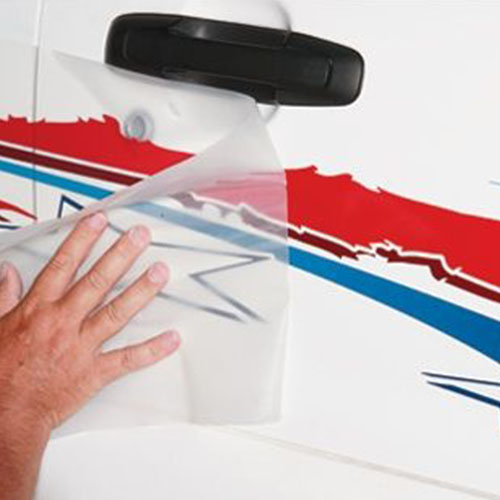
Vinyl Graphics
Whether you need text, logos or a full exterior redesign of your vehicle, Rodz Tint Touch has you covered with vinyl graphic installation services. Our team of experts can bring your desired designs to life and apply them seamlessly to the body of any automobile. With our vast experience, creativity and state of the art equipment, no job is too big or too small for us to handle.
Vinyl graphics are often used for personalization on cars, SUVs and pickup trucks. For businesses, they need to have their names, logos and colors on their vehicles for branding reasons. Rodz Tint Touch can do both jobs with equally high levels of proficiency. Vinyl graphics are popular among our clients thanks to its cost-effectiveness, quick installation and eye-pleasing results.
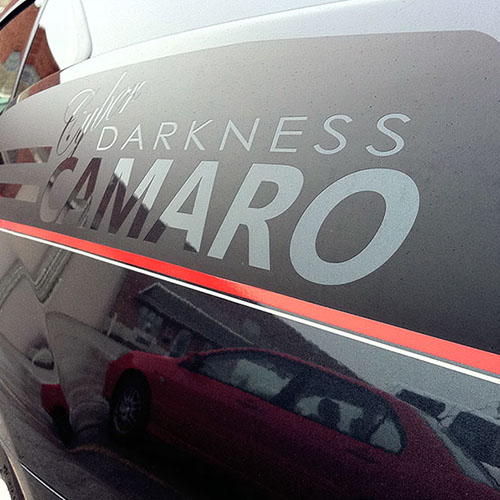
Vinyl Pinstripes
Does vinyl pinstriping on automobiles sound old-fashioned to you? Think again. Pinstripes are making a comeback of sorts and cars with these accents are turning heads on streets across America. Whether you want something to accentuate racing stripes on your car’s body or you just want subtle aesthetic touches to make your vehicle a little less plain, this might just be what you need.
Vinyl pinstriping is a delicate and exact process that requires expert hands and state of the art equipment. Fortunately, we have both of those in spades. Our team of vinyl wrap experts can apply pinstripes at the exact spots on your vehicle body to make sure they’re evenly installed and are complementary to your car’s current aesthetic motif.
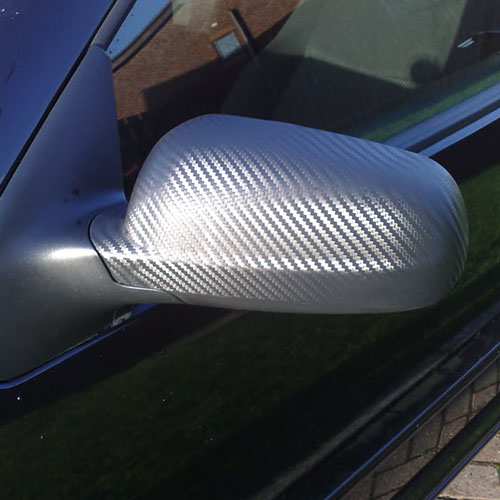
Side Mirror Vinyl Wrap
You may not realize it, but side mirrors are more prone to scratches and damage than just about any part of your car. The fact that they’re spread out means that they have a higher tendency to get hit by pebbles, seeds and other debris that go flying on the road at high speeds. Installing vinyl wrap on your side mirrors not only adds an aesthetic flair, but they also provide an extra layer of protection that can shield your mirrors from small impacts.
If you decide to get your side mirrors vinyl wrapped, come to Rodz Tint Touch for professional installation services. Side mirrors are particularly tough to vinyl wrap due to their curvatures and irregular shapes. It takes a lot of experience to wrap them in a way that the vinyl doesn’t wrinkle, bubble up or tear. Thankfully, our team of installers have done this job dozens of times and they’ll give your side mirrors a look that’s almost indistinguishable from factory painted ones.
Vinyl wrapping is the process of covering anything with sheets of vinyl for decorative and protective reasons. In the automotive industry, this is done by manually installing pressure-sensitive vinyl sheets over an entire vehicle’s body or just sections of it. When applied correctly, vinyl will look like your car’s factory-painted surface and will hardly be distinguishable from the original paint and clear coat unless closely inspected by a trained eye.
As far as aesthetics go, vinyl wrap can accentuate your car’s original design or even change its venture color scheme. From a protective standpoint, the vinyl wards off scratches, dents and chipping caused by small debris hitting your vehicle’s body at high speeds. Unlike car paint, vinyl is temporary and can be removed rather quickly without peeling off your car’s paint or damaging its clear coat. You might be amazed at how much this helps preserve your vehicle’s overall resale value.
Hoods, roofs and side mirrors are the parts of vehicles that are commonly wrapped. Vinyl wrapping is also popularly used on trucks, SUVs and boats. For business-owned vehicles vinyl can also be added to form logos and to display text for branding purposes.
Different manufacturers have slightly varying formulas for their vinyl wraps. However, the basic component is universally polyvinylchloride (PVC) polymer. This substance is rigid when it solidifies, so plasticizers need to be added to make it more flexible. In addition, heat stabilizers, fillers, processing aids, and special additives are used to form a film that’s durable and resistant to the elements. Finally, pigments are added to achieve a variety of colors that people would want to use on their vehicles.
The manufacturing process that’s most often used for creating quality vinyl wraps is known as casting. The alternative process is called calenaring, though it’s generally considered to be the one that produces lower-grade vinyl. The plasticizer used also has a significant impact on the film’s flexibility. Polymeric plasticizer is widely accepted as the high-grade option while monomeric plasticizers are less flexible but produce cheaper wraps. For the most part, Rodz Tint Touch encourages the use of higher-grade material for best results.
Vinyl wrapping is the process of covering anything with sheets of vinyl for decorative and protective reasons. In the automotive industry, this is done by manually installing pressure-sensitive vinyl sheets over an entire vehicle’s body or just sections of it. When applied correctly, vinyl will look like your car’s factory-painted surface and will hardly be distinguishable from the original paint and clear coat unless closely inspected by a trained eye.
As far as aesthetics go, vinyl wrap can accentuate your car’s original design or even change its venture color scheme. From a protective standpoint, the vinyl wards off scratches, dents and chipping caused by small debris hitting your vehicle’s body at high speeds. Unlike car paint, vinyl is temporary and can be removed rather quickly without peeling off your car’s paint or damaging its clear coat. You might be amazed at how much this helps preserve your vehicle’s overall resale value.
Hoods, roofs and side mirrors are the parts of vehicles that are commonly wrapped. Vinyl wrapping is also popularly used on trucks, SUVs and boats. For business-owned vehicles vinyl can also be added to form logos and to display text for branding purposes.
At Rodz Tint Touch, we recommend using cast vinyl wrap that uses polymer as the plasticizing agent. Brands such as Avery Dennison and 3M Graphics are reliable sources of this material. We advise our customers to use this type of wrap due to the following distinct advantages:
- This vinyl wrap can be made very thin without sacrificing durability and firmness. It’s the easiest to install even on uneven surfaces such as roofs your roof or your side mirrors.
- It’s not prone to wrinkling, bubbling or tearing thanks to its rigidity and pressure sensitivity.
- It resists the sun’s ultraviolet radiation better than other vinyl wrap types, allowing it to better protect your car’s body and fend off wear on its own surface.
- Thanks to the fact that cast vinyl wrap can be manufactured in small scales, there are more color choices in the market.
- Cast vinyl doesn’t shrink even after it’s installed and exposed to elements. This means that whatever look that you achieved after installation is completed will remain the way it is for years.
- Thanks to its high-grade composition and quality pigments for coloration, cast vinyl wrap with polymer plasticizer will look identical as a car’s factory painted surface.
Cast, polymeric vinyl wrap may be more expensive than lower-end materials, but it’s certainly the choice for people looking to get the best value for money.
Vinyl wrapping is the process of covering anything with sheets of vinyl for decorative and protective reasons. In the automotive industry, this is done by manually installing pressure-sensitive vinyl sheets over an entire vehicle’s body or just sections of it. When applied correctly, vinyl will look like your car’s factory-painted surface and will hardly be distinguishable from the original paint and clear coat unless closely inspected by a trained eye.
As far as aesthetics go, vinyl wrap can accentuate your car’s original design or even change its venture color scheme. From a protective standpoint, the vinyl wards off scratches, dents and chipping caused by small debris hitting your vehicle’s body at high speeds. Unlike car paint, vinyl is temporary and can be removed rather quickly without peeling off your car’s paint or damaging its clear coat. You might be amazed at how much this helps preserve your vehicle’s overall resale value.
Hoods, roofs and side mirrors are the parts of vehicles that are commonly wrapped. Vinyl wrapping is also popularly used on trucks, SUVs and boats. For business-owned vehicles vinyl can also be added to form logos and to display text for branding purposes.
Vinyl wrapping offers several key benefits including:
- Protection against UV rays that damage your factory paint
- Protection against debris such as stones, seeds, concrete chips and other high-speed road particles
- Protection from harmful UV rays that damage your car’s paint.
- Protects your factory paint from fading, preserving your vehicle’s residual value
- Easy to remove and will not damage your factory paint
- It’s highly versatile and can wrap your entire vehicle or just parts that you want to customize.
- Can be cut into custom shapes, logos and text for maximum customization.
- Virtually indistinguishable from paint.
- Comes in a wide range of colors.
These benefits can be reaped as long as the vinyl wrap is properly installed. Rodz Tint Touch has the experts and equipment to do a perfect application job each and every time.
Vinyl wrapping is the process of covering anything with sheets of vinyl for decorative and protective reasons. In the automotive industry, this is done by manually installing pressure-sensitive vinyl sheets over an entire vehicle’s body or just sections of it. When applied correctly, vinyl will look like your car’s factory-painted surface and will hardly be distinguishable from the original paint and clear coat unless closely inspected by a trained eye.
As far as aesthetics go, vinyl wrap can accentuate your car’s original design or even change its venture color scheme. From a protective standpoint, the vinyl wards off scratches, dents and chipping caused by small debris hitting your vehicle’s body at high speeds. Unlike car paint, vinyl is temporary and can be removed rather quickly without peeling off your car’s paint or damaging its clear coat. You might be amazed at how much this helps preserve your vehicle’s overall resale value.
Hoods, roofs and side mirrors are the parts of vehicles that are commonly wrapped. Vinyl wrapping is also popularly used on trucks, SUVs and boats. For business-owned vehicles vinyl can also be added to form logos and to display text for branding purposes.
In the recent past, Plasti-Dip has been marketed as a viable alternative to vinyl wraps for car customization and full-body color change jobs. Its purveyors describe it as a cheaper, easier-to-apply solution that does everything that vinyl does – but does it really?
Here at Rodz Tint Touch, we get asked that question a fair bit and the answer is always a resounding NO. Vinyl has a multitude of key advantages over Plsti-Dip which makes the comparison a non-issue. Vinyl is still better in every way and here’s why from several angles:
Installation
Plasti-Dip purveyors market the product as a DIY solution for partially or totally covering your vehicle’s body. While there may be some truth to that, what they’re not telling you is that you need special skills and experience to get the job done., At Rodz Tint Touch, we make no such claims with vinyl wrap jobs. We know that specialized tools, knowledge and expertise is necessary to get a good job done. We tell you right from the get-go that this is a job that’s best left to the professionals and it will cost you a little extra. In return, you’re guaranteed a car wrap that’s bubble and wrinkle-free. It’ll also stay securely attached to your vehicle for 5-7 years depending on environmental conditions and your care for your wrap.
Aesthetics
Simply put, vinyl just looks flat out better than Plasti-Dip when it’s on your car. Despite Plasti-Dip’s improvements in adding a glossy layer to its surface, it still can’t compete with the technology that’s used in today’s high-quality vinyl wraps which look identical to the body of a car that just came out of a factory assembly line. One look at a car with Plasti-Dip and most car enthusiasts will be able to tell what it is. With vinyl, they’ll have to examine your car’s body to make sure that it wasn’t custom-painted by car body work experts.
Durability
Plasti-Dip is just not as good as vinyl wrap when it comes to the durability and longevity departments. For starters, Plasti-Dip has a high chance of bubbling up or shrinking when exposed to the summer sun, heavy rain or harsh winters. It also tends to chip and dent easily from impact made by small debris on the road to your car’s body. With vinyl wraps, that’s not the case. This material will hold up in practically any environment and it’ll stay looking good for at least half a decade. The installation process used on vinyl wrap also guarantees that it won’t peel or flake off. The same could not be said about Plasti-Dip which usually offers no assurances of that sort.
Ease of Removal
Vinyl wrap will hold on to your car’s body for years and years, protecting it and making it look better at the same time. When the time comes to remove or replace it, however, it will come off easily and cleanly without leaving a mark on your vehicle’s original paint. The same doesn’t apply to Plasti-Dip. That material requires the application of specialized chemicals for removal. If you’re not careful, these substances can make contact with your car’s body and damage its original paint.
If you’re looking to customize or fully cover your car, this debate is a no-brainer. Vinyl wrap may cost more and take a little longer to apply, but its quality, durability and aesthetic value more than justify the investment that you’ll make.
It might be a cliché, but the adage “you get what you pay for” holds true for a lot of things, including vinyl wraps. You see, not all vinyl wraps are made equal. Some manufacturers such as 3M make vinyl wraps with quality in mind. Others focus more on dropping the price, forsaking quality in the process.
At Rodz, we have nothing against our customers saving a pretty penny on their car customization expenses. However, we do advise them to look less on price tags and more on value for money when it comes to installations such as vinyl wrapping. Far too often, we see customers trying to pinch a few dollars and ending up regretting it because of the headaches that they get in the aftermath. Here are just some of the most common issues we see from people who opted for cheap vinyl wrapping:
Wrinkling
Cheap vinyl wraps may look awesome when they’re newly installed, but wait until they get exposed to rain, heavy winds, summer suns or snow. You’ll start to see small wrinkles that grow longer over time, making your car look worse than it might have looked prior to wrapping. Good quality vinyl wraps such as that from 3M are guaranteed to resist wrinkling even after years of heavy duty use. The wrap will always look identical to you vehicle’s body and it will always look like it was painted on instead of being a sheet that was applied on top of your vehicle’s original surface.
Shrinkage
If you’ve ever bought cheap clothing that shrunk after a couple of spins in the washing machine, you might be surprised to know that this has an equivalent in the automotive world. Cheap vinyl wraps can shrink significantly after being exposed to the elements, loosening its adhesive grip on your car’s body and exposing portions of your car’s original surface. Worse, shrinkage is often accompanied by bubbling and wrinkling, which can make your vehicle look uglier instead of better as you originally intended. To avoid this nightmare, be sure to get premium vinyl wraps from trusted brands. They might be worth a little more, but they won’t give you any problems at all in the years to come.
Bubbling
Bubbling is one of the most common problems that people encounter when using cheap vinyl wraps. This happens when the material and its adhesives are exposed to intense sunlight for several hours. The material and the fluids expand, forming unsightly bubbles of varying sizes on your vehicle’s new surface. To make sure that your car, truck or SUV doesn’t end up looking like it was attacked by a swarm of insects, get only premium vinyl wraps from brands that are trusted throughout the industry.
Discoloration
Cheap vinyl wrap may dodge the bubbling, shrinkage and wrinkling bullets, but it will almost certainly start fading in spots. Vinyl wrap is supposed to look exactly like a painted car surface from the moment that installation is finished and for up to seven years after that. With low-cost wraps, you’ll be fortunate to not see any discoloration on the material within two years.
Cracking
Dry and warm weather causes cheap vinyl wraps to harden and crack after a few days of exposure. This leaves your vehicle looking old and damaged even if the original surface actually isn’t. Quality wraps do not have this problem and will not crack even in sunny states such as Florida, Nevada, California and Arizona.
Chipping
One of vinyl wrap’s main functions is to protect your car’s original clear coat and paint. Cheap wraps struggle to do that because they tend to chip and dent from minor impacts with tiny debris on the road. A small pebble or a grain of corn flying at your vehicle’s body can be deflected by quality wraps without leaving much of a mark. Cheap wraps, however, will likely show a scar from such an incident.
Seam Visibility
Seams are part of the vinyl wrapping process, but high-end wraps are thick enough to cover the seams, making them invisible especially when the wrap was installed by a team of experts. Cheap vinyl wraps, however, don’t have this feature and will end up making your car, truck or SUV looking like it’s fresh off of a surgeon’s table.
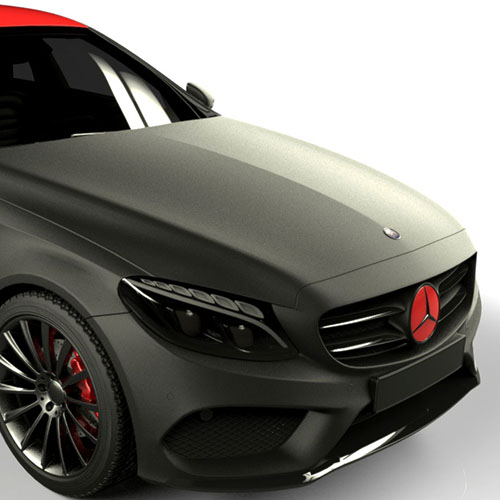
How Long is the Lifespan of Vinyl Wrap on a Car?
On average and with typical American usage, the wrap should be just fine for 5 to 7 years. However, this can shorten or lengthen depending on weather and usage conditions it’s subjected to. If your car is parked in a garage most of the time, the wrap can last a decade. If you’re always on the road and your car is always parked outside, 3-4 years is a more realistic time frame. Fortunately, Rodz Tint Touch installers can give you several pieces of advice on how to take care of your vinyl wrap.
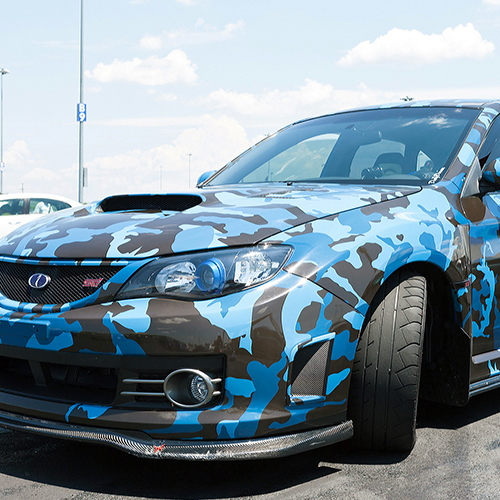
How Much Does Vinyl Wrapping Cost?
This depends on several key factors such as vehicle type, vehicle size, the type of vinyl wrap you choose and the complexity of your desired customization. Give us a call or drop by our workshop for an accurate quote. The only thing we can guarantee you is that vinyl wrapping always costs a fraction of what having your car painted would cost.

Will Car Washing Damage My Vinyl Wrap?
The surface of vinyl can be put through a car wash safely just like your car’s factory painted surface. However, care needs to be applied when washing around the vinyl’s edges and seams to prevent water seepage under the wrap. This could weaken the bond of the material on your car’s body and produce bubbles or wrinkles over time. For best results, consult your installer on how to avoid water damage on your vinyl wrap installation.
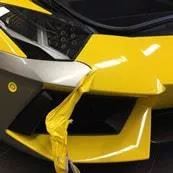
Is It Better to Have a Fully Wrapped Car or a Partially Wrapped One?
This depends on your aesthetic and design objectives. If you just want racing stripes or a different-colored hood, partial wrapping will be more satisfying for you. However, full vinyl wraps are better from a protection standpoint. When you wrap all of your vehicle’s surface area, you evenly protect every inch of it. Full wraps are also less prone to water seepage due to the limited length of seams and edges. Fully-wrapped vehicles are better at preserving their original body paint, granting them greater residual value.
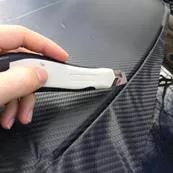
How Long Does the Vinyl Wrapping Process Take?
This one is also dependent on the size of the vehicle and the complexity of the job. Typically, 24 to 48 hours is enough for simple partial and full wraps. For more complex wrapping jobs, we might ask for an extra day to make sure your car comes out of Rodz Tint Touch perfectly.
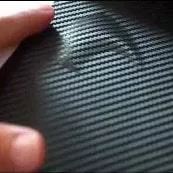
Are Bubbles and Wrinkles Normal on a Wrapped Car?
Absolutely not. You should expect your car’s vinyl wrap to come out looking like it was factory painted. That means absolutely no wrinkles, tears and bubbles. Seams are often required no matter how skilled and professional the installation service providers are, but a quality wrapping job will be able to hid necessary seams well out of sight.

